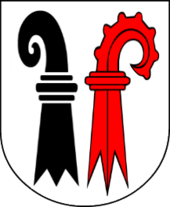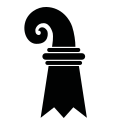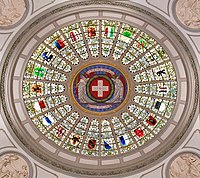Canton of Basel
| Canton of Basel Kanton Basel | |||||||||||
|---|---|---|---|---|---|---|---|---|---|---|---|
Restoration Switzerland | |||||||||||
| 1501–1833 | |||||||||||
half-cantons | 16 August 1833 | ||||||||||
| |||||||||||
Basel was a
Background

Before the
Establishment
As a direct consequence of the Swabian War, resolved by the 1499 Treaty of Basel, Basel and the Imperial City of Schaffhausen joined the Swiss Confederation in 1501, as the confederacy's 11th and 12th states, with Appenzell following suit 12 years later to complete the Dreizehn Orte that made up Switzerland until the French Revolutionary Wars.
The canton of Basel seceded from the prince-bishopric, and the secular rule of the bishops of Basel from this time was limited to territories west of Basel, more or less corresponding to the modern
Reformation
In 1503, the new bishop Christoph von Utenheim refused to give Basel a new constitution whereupon, to show its power, the city began the construction of a new city hall.[2] The reformation was brought to Basel by Johannes Oecolampadius cathedral preacher under von Utenheim and co-editor of Erasmus' first edition of the Greek New Testament. Von Utenheim resigned on 19 February 1527. He was succeeded by Philippe von Gundelsheim, canon at Basel Münster since 1510.
In 1529, the city became Protestant under Oecolampadius and the bishop's seat was moved to Porrentruy. In 1530,
The Basel patriciate (
Intended as a defence of
The first edition of Christianae religionis institutio (
The 1648 Peace of Westphalia finally brought about Imperial recognition of the independence of the Swiss cantons, removing the de jure (but not de facto) overlordship of the Holy Roman Empire rejected by the then–Prince-Bishopric nearly 150 years earlier.
Unrest and insurrection
In 1792, the
Until 1830, Basel was a unified canton, with citizens from both the city and the municipalities of the countryside sitting in the Kantonsparlament. The cantonal parliament was dominated by members from the city, though its population was less than that of the combined countryside. This had not previously been a source of grievance, but in 1830 the Baselbieter, or citizens from the countryside, grew increasingly distrustful of the city. At a meeting in Bad Bubendorf on 18 October 1830, 25 Baselbieter wrote to the "esteemed gentlemen and noblemen in Basel", demanding equal rights between city and countryside and a representation in parliament in proportion to their numbers.
When the city rejected this demand, resentment from the countryside region grew still larger to the extent that the city feared an attack. In Liestal a few men of the countryside formed a new provincial government protected by an army of 3,000. The government was however short-lived as on 16 January 1831 a force from Basel occupied Liestal, driving out the new government. A number of villages, such as Gelterkinden, Reigoldswil, Anwil and Bubendorf remained loyal to Basel, though coming under threat from the rebels. The unrest in the countryside persisted into 1832 and both sides committed injustices upon the other.
On 3 August 1833 over 1200 troops of the city armed with 14 cannons marched on Liestal, but at the Battle of Hülftenschanz, which took place between Pratteln and Frenkendorf, the city's troops were forced back to Basel by the superior numbers of the rebels. Their route back to the city was ambushed and the city forces took heavy losses.
Partition

After this conflict, the highest Swiss authority, the
From the country municipalities it allocated only
The
Suggested re-unification
Several attempts have been made to reunite Basel-City and Basel-Country. In 1969, the citizens of Basel-Country defeated the motion in a referendum. The two cantons have since concluded a number of co-operation agreements, such as joint financing and governance of the University of Basel.
References
- Swiss Constitutionof 1999, paragraph 142.4)
- ^ Habicht, Peter, Basel - A Center at the Fringe (Basel: Christoph Merian Verlag, 2006) pp. 43, 55, 70, 79.
- ^ Surchat, Pierre Louis, „Philipp von Gundelsheim“, in: Neue Deutsche Biographie 20 (2001), S. 373 f. [Onlinefassung]; URL: http://www.deutsche-biographie.de/pnd100536808.html
- Charles Loch Mowat, The New Cambridge Modern History, 1990, p. 113
- ^ The Illustrations from the Works of Andreas Vesalius of Brussels, Courier Dover Publications 1973, p.30
External links
- Coolidge, William Augustus Brevoort (1911). . Encyclopædia Britannica. Vol. 3 (11th ed.). p. 462.
- Canton of Basel in German, French and Italian in the online Historical Dictionary of Switzerland.



